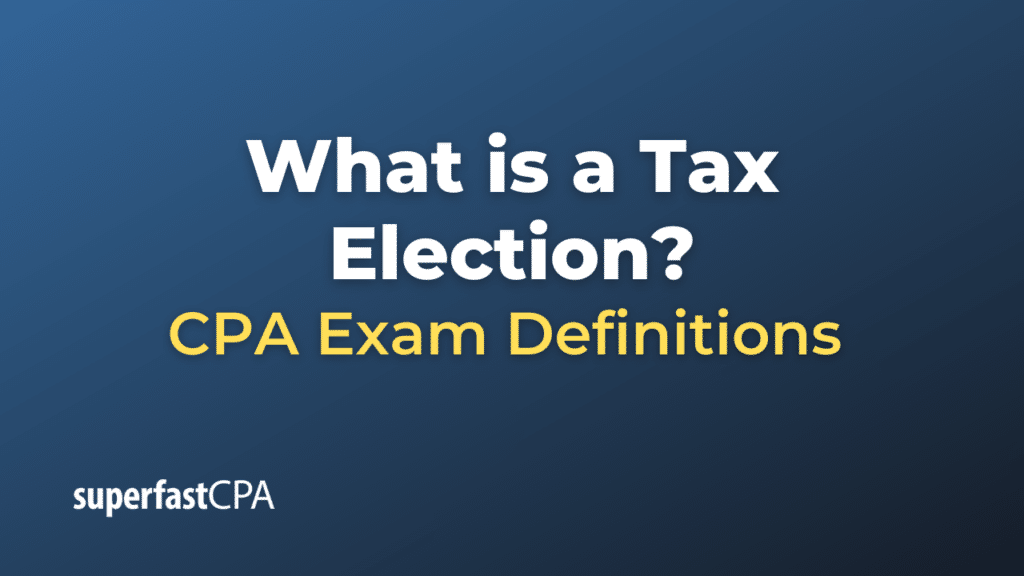Tax Election
A tax election is a choice made by a taxpayer, either an individual or an entity, to apply a specific tax treatment to a particular situation or transaction. This choice typically involves selecting one allowable method or treatment over another under the tax code. Once made, a tax election can influence the timing and manner in which income, deductions, gains, or losses are reported for tax purposes.
Here are some key aspects and examples of tax elections:
- Flexibility: The tax code in many countries, including the U.S., often provides taxpayers with options on how to treat specific items or situations, recognizing that a single set of rules might not be appropriate for every taxpayer or every situation.
- Formal Process: Making a tax election often involves a formal process, such as completing a particular form or providing a statement attached to a tax return.
- Irrevocability: Some tax elections, once made, are irrevocable unless the tax authorities grant permission to change. Others can be changed in subsequent years, but changing might have other tax consequences.
- Planning Opportunity: Tax elections present planning opportunities. Taxpayers, often with the advice of tax professionals, might make a particular election to minimize tax liability, defer taxes, or align tax treatment with their financial or business goals.
Examples of Tax Elections:
- S Corporation Election (U.S.): Eligible corporations or LLCs can choose to be treated as an S Corporation by filing Form 2553 with the IRS. This election allows income, deductions, and credits to flow through to shareholders, avoiding double taxation typical of C Corporations.
- Section 179 Deduction (U.S.): Businesses can elect to deduct the full cost of certain qualifying property in the year it’s placed in service, instead of depreciating it over several years.
- Capital vs. Ordinary Expense (U.S.): If a taxpayer makes repairs to a business property, they can decide whether to capitalize the cost (adding it to the asset’s basis and depreciating it) or treat it as an ordinary expense deductible in the year incurred.
- Foreign Earned Income Exclusion (U.S.): U.S. citizens or resident aliens living abroad can elect to exclude a certain amount of foreign-earned income from U.S. taxable income.
The above are just a few examples, and tax codes worldwide contain numerous elections tailored to specific situations. Making the right tax election can be beneficial, but it’s essential to be informed and often helpful to consult with tax professionals.
Example of a Tax Election
Let’s delve deeper into the concept of a tax election using the “S Corporation Election” in the U.S. as an example.
Scenario:
Emma owns a tech consulting firm, “TechBridge LLC.” When she first established her company, it was set up as a Limited Liability Company (LLC), and the profits and losses from the business flowed directly to her personal tax return. This is the default tax treatment for single-member LLCs in the U.S., which are considered “disregarded entities” for tax purposes.
However, as TechBridge LLC grew and became more profitable, Emma learned about the potential tax benefits of having her LLC treated as an S Corporation for tax purposes. After consulting with her tax advisor, Emma decided to make the S Corporation election.
Benefits of the S Corporation Election:
- Avoiding Self-Employment Taxes: One of the primary reasons many business owners choose the S Corporation election is to potentially save on self-employment taxes. With an S Corporation, Emma can pay herself a “reasonable” salary, which is subject to Social Security and Medicare taxes. Any additional profits beyond this salary can be distributed as dividends, which aren’t subject to these taxes.
- Flow-through Taxation: Just like the default LLC tax treatment, S Corporations are flow-through entities. This means the corporation itself doesn’t pay federal income taxes. Instead, the income, deductions, and credits flow through to the owners’ individual tax returns.
Making the Election:
Emma completed IRS Form 2553, “Election by a Small Business Corporation,” and submitted it to the IRS within the required timeframe. The form required details about the LLC, its shareholders, and their consent for the election.
Outcome:
By making the S Corporation election:
- Emma pays herself a reasonable salary of $80,000 annually. This salary is subject to self-employment taxes.
- TechBridge LLC made a profit of $150,000 this year. After deducting Emma’s salary, there’s a remaining profit of $70,000. This amount can be distributed as dividends, avoiding additional self-employment taxes.
- Both Emma’s salary and the dividend distributions are reported on her individual tax return, and she pays income tax accordingly.
This example showcases how a tax election (in this case, the S Corporation election) can provide beneficial tax treatment in certain scenarios. However, it’s crucial to note that there are specific requirements and potential complexities associated with S Corporations, so it’s always advisable to consult with a tax professional before making such decisions.













